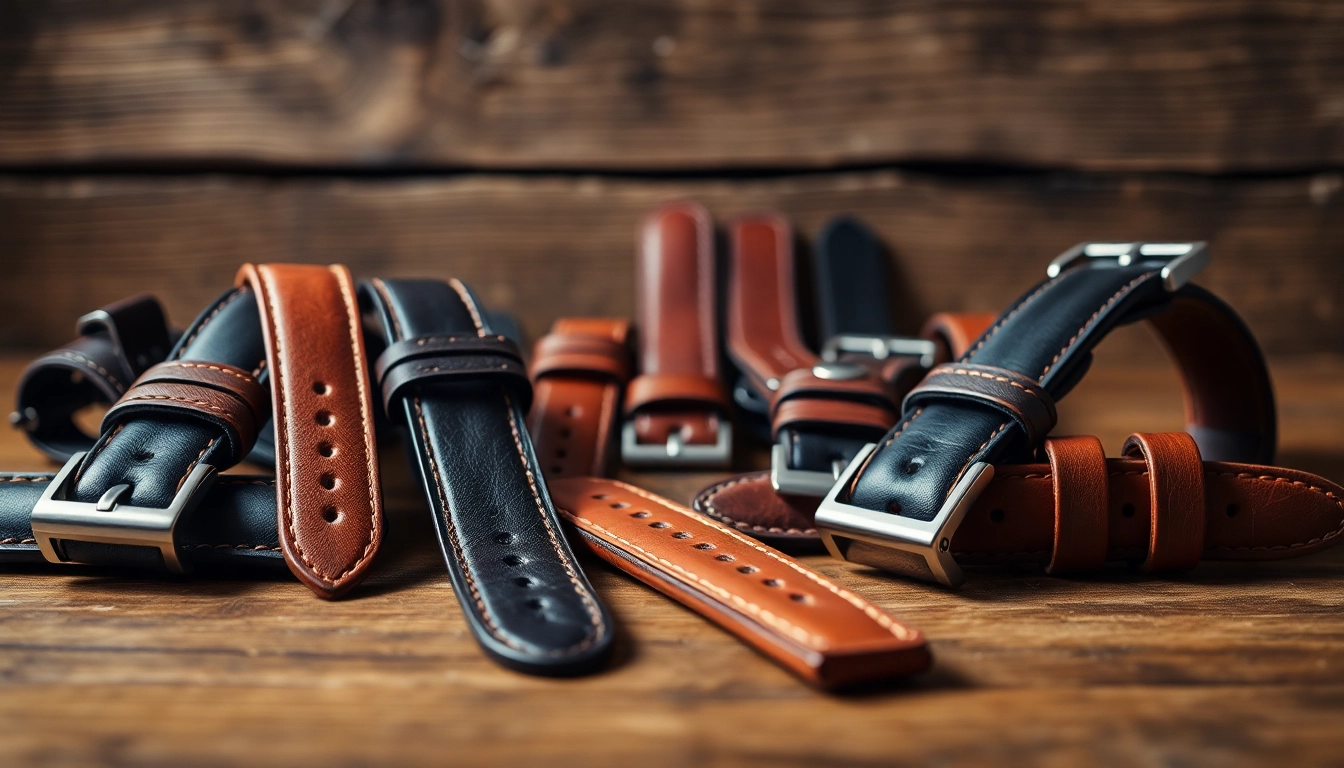Understanding Leather Watch Straps
Leather watch straps have become synonymous with elegance, durability, and sophistication. They add a touch of class to any timepiece, making them a favorite among watch enthusiasts and casual wearers alike. While the appeal is clear, understanding the different aspects of leather watch straps—from materials to benefits—can help you choose the right one. Investing in quality leather watch straps not only enhances the look of your watch but can also improve its longevity. Explore the world of leather watch straps below to guide your selections wisely.
Types of Leather Used
Leather watch straps are made from various types of leather, each having its unique characteristics, grain patterns, and durability levels. Understanding these types is crucial to making an informed decision:
- Top Grain Leather: This type is made from the top layer of the hide, showcasing its natural grain while being sanded down for a smoother finish. It strikes a balance between price and quality.
- Full Grain Leather: The most durable and high-quality type, full grain leather retains the hide’s rough texture and natural imperfections, reflecting authenticity. It develops a rich patina over time.
- Genuine Leather: Often a catch-all term, genuine leather is usually lower quality and less expensive. It can lack the unique characteristics of higher-grade leathers.
- Exotic Leathers: These include materials like ostrich or alligator leather, renowned for their luxe look and feel but often at a premium price.
Benefits of Leather Watch Straps
Choosing leather watch straps comes with an array of benefits that enhance both style and functionality:
- Timeless Aesthetic: Leather resonates with classic beauty, effortlessly adapting to both formal and casual styles.
- Comfort: Over time, leather conforms to the wearer’s wrist, providing unmatched comfort compared to many synthetic alternatives.
- Durability: When properly cared for, leather can last for years, making it a great value for your investment.
- Versatility: Leather can be dyed in various colors and styles, allowing for a wide selection that speaks to personal taste.
How to Identify Quality Leather Straps
With so many options available, identifying high-quality leather watch straps is vital:
- Check the Grain: Quality leather will show a natural grain pattern, with irregularities that indicate it is genuine.
- Examine the Edges: Smooth, well-finished edges are a sign of craftsmanship. Poorly cut or unfinished edges often indicate lower quality.
- Smell the Leather: Real leather has a distinct smell, while synthetic materials tend to have a plastic-like odour.
- Feel the Texture: The leather should have a soft, pliable feel that becomes more supple over time.
Choosing the Right Style
With an extensive variety of leather watch straps available, narrowing down options to find the perfect style can be challenging. Here’s how you can effectively choose:
Casual vs. Formal Leather Watch Straps
It’s important to match your leather watch straps with the intended occasion:
- Casual Straps: Often made from textured leather and in a variety of colors, casual straps allow for more playful expressions. They’re ideal for everyday wear and blend well with casual attire.
- Formal Straps: Sleeker and more refined, formal straps typically utilize polished leather, exuding an air of sophistication suitable for business or formal events.
Color Variations and Their Impact
The color of leather watch straps can significantly affect your overall appearance:
- Black: A classic and versatile option, black leather straps complement almost any outfit.
- Brown: Ranging from light to dark, brown leather offers warmth and works beautifully with casual and semi-formal outfits.
- Colored Straps: Bright or unusual colors can make a bold statement but should be selected with consideration of the watch and occasion.
Popular Designs and Trends
Trends in leather watch straps can vary; however, some styles persistently stand out:
- Textured Designs: Straps with unique patterns, such as crocodile or ostrich, can highlight individuality.
- Minimalist Straps: Sleek, unembellished designs resonate well with modern aesthetics, often favored for their clean looks and simplicity.
- Multi-Functional Straps: Straps capable of transitioning from casual to formal by utilizing removable buckles or quick-release mechanisms are becoming increasingly popular.
Maintenance and Care for Leather Watch Straps
To prolong the life and maintain the appearance of leather watch straps, proper care is essential:
Cleaning and Conditioning Tips
Regular cleaning and conditioning can enhance the appearance and longevity of leather straps:
- Keep it Dry: Avoid exposing the leather to water. If it does get wet, dry it gently with a soft cloth and let it air dry away from heat sources.
- Use a Leather Cleaner: Use a pH-balanced leather cleaner to wipe off dirt and grime. Follow up with a leather conditioner to nourish the material.
- Avoid Harsh Chemicals: Steer clear of using alcohol, bleach, or ammonia-based products, as they can damage the leather.
How to Store Leather Straps Properly
Proper storage preserves the quality of leather watch straps:
- Hang or Lay Flat: Avoid crumpling by laying straps flat or hanging them in a cool, dry place.
- Avoid Sunlight: Prolonged exposure to sunlight can fade the leather and lead to cracks. Store in a dimly lit area.
Repairing Minor Damages
Even the best leather watch straps may incur minor damages. Here’s how to address them:
- Scuffs and Scratches: Light scratches can often be treated using leather conditioning products. Rub gently using a cotton cloth.
- Stitching Issues: Loose threads or broken stitches may require professional repair. Avoid DIY stitching unless you have the experience to secure the integrity of the strap.
Finding Your Ideal Fit
The fit of your leather watch straps is critical not only for comfort but also for enhancing the overall look of the watch. Here’s how to find your ideal fit:
Measuring for the Right Size
Finding the correct size ensures that the strap fits comfortably while maintaining watch functionality:
- Wrist Measurement: Measure your wrist using a soft tape measure to find your size. Most straps can accommodate adjustments through holes.
- Watch Lug Width: The width between the lugs of your watch determines what size strap you will need. Ensure that the width of the strap matches this measurement.
Adjustments and Comfort Considerations
Fine-tuning the fit will contribute to a more enjoyable wearing experience:
- Adjustable Straps: Some leather straps come with multiple holes or quick-release mechanisms for easy adjustments.
- Comfort Fit: Aim for a snug fit that still allows for slight movement without excessive pressure on your wrist.
Mixing and Matching with Watches
Knowing how to pair straps with watch styles can elevate your timepiece:
- Sport Watches: Typically suited to thicker, durable leather that can withstand wear and tear.
- Dress Watches: Lean towards slimmer, more elegant straps that enhance the watch’s sophistication.
Where to Buy Quality Leather Watch Straps
Finding reputable sources for leather watch straps can make a significant difference in your purchasing experience:
Identifying Reputable Retailers
Becoming familiar with reputable retailers ensures you invest in quality products:
- Customer Reviews: Look for retailers with positive customer feedback regarding product quality and service.
- Return Policies: A generous return policy can provide assurance in case the fit or quality does not meet your expectations.
Online vs. Local Shopping Options
Choosing between online and local stores has its pros and cons:
- Online Shopping: Enjoy greater variety, often at better prices. However, not being able to see and feel the product in-person can be a disadvantage.
- Local Shopping: Allows for hands-on inspection, which can help in assessing quality. However, variety may be limited compared to online offerings.
Understanding Pricing and Value
Investing in leather watch straps can vary widely in costs. Consider the following:
- Material Costs: Higher quality leather generally comes at a higher price point, reflecting durability and craftsmanship.
- Brand Value: While well-known brands might charge more due to reputation, some lesser-known options can provide equivalent quality.



